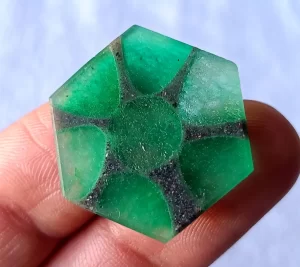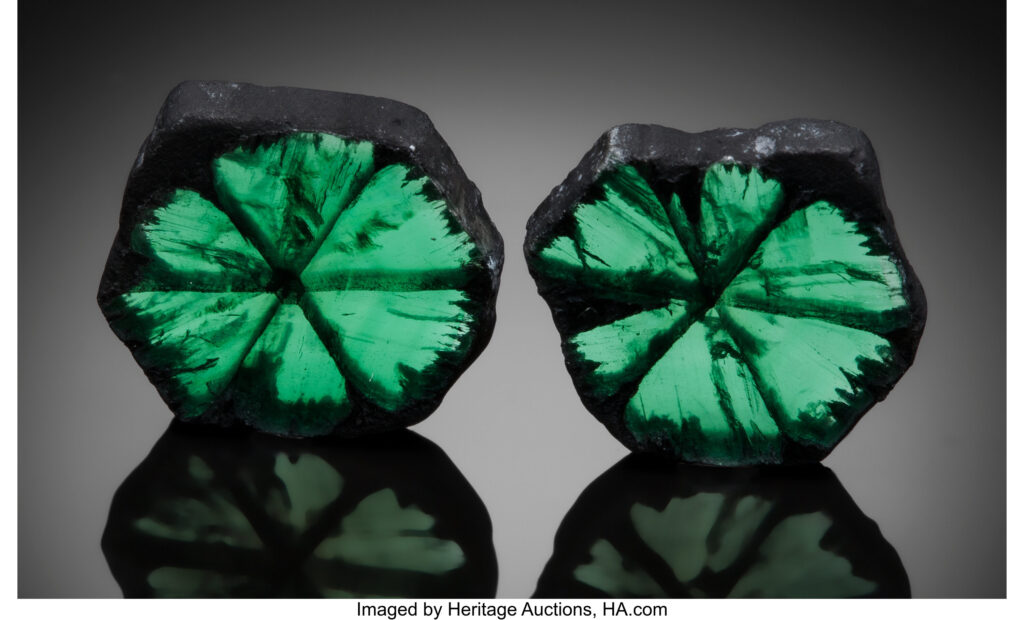Trapiche emeralds derive their name from the Spanish term “trapiche,” which refers to a grinding wheel used in sugar mills. This name aptly captures the gemstone’s distinctive six-pointed radial pattern, reminiscent of the spokes of a wheel. Predominantly sourced from Colombia, these extraordinary emeralds hail from the renowned Muzo and Chivor mines. Nestled in the Eastern Cordillera of the Andes, this region is celebrated for its rich geological diversity and abundant mineral wealth.
 The Formation Journey of Trapiche Emeralds
The Formation Journey of Trapiche Emeralds
Trapiche emeralds form under specific high-pressure and high-temperature conditions in hydrothermal veins deep within the Earth’s crust. These veins are infiltrated by hydrothermal fluids rich in beryllium and various trace elements. As these fluids gradually cool, they give rise to the formation of emerald crystals.
The hallmark trapiche pattern emerges due to the presence of black carbon impurities or other minerals like albite. These impurities intersect with the emerald’s hexagonal crystal structure. During the crystallization process, the inclusions are pushed toward the center of the crystal, creating the characteristic spoke-like pattern. This happens because the growth of the emerald crystal is periodically interrupted by these impurities, which segregate into distinct radial arms extending from the core of the crystal.
 The Allure and Uniqueness of Trapiche Emeralds
The Allure and Uniqueness of Trapiche Emeralds
Each trapiche emerald is a one-of-a-kind marvel, with patterns varying significantly from stone to stone. Some may showcase a flawless six-pointed star, while others exhibit partial or less symmetrical formations. The precise geological conditions needed to create a trapiche emerald are exceedingly rare, further enhancing the stone’s uniqueness and value.
The trapiche pattern’s captivating beauty and rarity make these emeralds highly prized among gem collectors and jewelry enthusiasts. Their formation process, deeply intertwined with the earth’s geological history, adds a layer of intrigue and fascination.
 Origins and Formation of Trapiche Emeralds
Origins and Formation of Trapiche Emeralds
Trapiche emeralds derive their name from the Spanish term “trapiche,” which refers to a grinding wheel used in sugar mills. This name reflects the gemstone’s characteristic six-pointed radial pattern, reminiscent of wheel spokes. These unique emeralds are primarily found in Colombia, particularly in the renowned Muzo and Chivor mines, known for producing some of the world’s finest emeralds. These mines are situated in the Eastern Cordillera of the Andes, an area celebrated for its geological diversity and mineral abundance.
 Formation Process
Formation Process
Trapiche emeralds form in hydrothermal veins under high-pressure and high-temperature conditions, typically deep within the Earth’s crust. Hydrothermal fluids, rich in beryllium and other trace elements, infiltrate the surrounding rock. As these fluids cool, they lead to the formation of emerald crystals.
The distinctive trapiche pattern arises due to the presence of black carbon impurities or other minerals like albite. These impurities intersect with the emerald’s hexagonal crystal structure. During crystallization, these inclusions are pushed towards the center of the crystal, forming a radial, spoke-like pattern. This phenomenon occurs because the crystal’s growth is interrupted by these impurities, which segregate into distinct arms radiating from the core.
 Unique Characteristics
Unique Characteristics
This intricate formation process makes each trapiche emerald a unique masterpiece. The radial pattern can vary significantly among stones, with some displaying a perfect six-pointed star, while others exhibit partial or irregular formations. The rarity of the precise conditions required to form a trapiche emerald adds to the gemstone’s uniqueness and value.
Colombia’s specific geological conditions, including its tectonic activity and rich hydrothermal systems, contribute to the prevalence of trapiche emeralds in this region. Colombian emeralds are renowned for their exceptional quality and vibrant green color, attributed to trace elements such as chromium and vanadium. The combination of these elements with the unique formation process results in the stunning and rare trapiche emeralds.
 The Enchanting Features of Trapiche Emeralds
The Enchanting Features of Trapiche Emeralds
The most captivating feature of a trapiche emerald is its star-like pattern, consisting of six rays that extend from the center to the edges of the crystal. This pattern is often symmetrical and can manifest as either a complete or partial star. The rays are usually composed of dark inclusions, creating a striking contrast against the vibrant green of the emerald.
Variability in Trapiche Patterns
The trapiche pattern can vary significantly from stone to stone. Some trapiche emeralds showcase a perfectly symmetrical six-rayed star, while others may display incomplete or irregular rays. Depending on the formation conditions, the pattern can sometimes resemble a cross or an asterisk.
Typical Emerald Qualities
In addition to their distinctive star-like pattern, trapiche emeralds exhibit the classic qualities of emeralds, such as a rich green color and a vitreous luster. The green hue of trapiche emeralds can range from light to dark, influenced by trace elements like chromium and vanadium. These elements impart the renowned vibrant green color to Colombian emeralds, including trapiche varieties, making them some of the most desirable emeralds in the world.
 Factors Influencing Value
Factors Influencing Value
Several factors influence the value of a trapiche emerald. Unlike traditional emeralds, where clarity is paramount, trapiche emeralds are valued more for the intensity and uniformity of their green color, as the inclusions form the hallmark pattern. A vivid, deep green is typically more highly prized.
Trapiche pattern and Asterism
The distinctiveness and symmetry of the trapiche pattern are also crucial. A well-defined, symmetrical star pattern is more desirable and therefore more valuable. The contrast between the dark rays and the green of the emerald enhances the stone’s visual appeal, with sharper contrasts being preferred. Larger trapiche emeralds with a clear and prominent pattern are especially rare and sought after, further increasing their value.
Both the trapiche pattern and asterism create captivating star-like visuals in gemstones, yet they arise from distinct formation processes, occur in different types of gemstones, and display unique visual characteristics.
Trapiche Pattern
Formation Process: The trapiche pattern is a result of specific geological conditions and the unique way certain crystals, particularly emeralds, form. This pattern develops due to the presence of inclusions such as black carbon or other minerals. As the emerald crystalizes, these inclusions are pushed to the center, creating a characteristic six-rayed radial star.
Types of Gemstones: The trapiche pattern is most notably found in emeralds but can also occur in other gemstones like rubies, sapphires, and tourmalines.
Visual Characteristics: The pattern features a six-rayed star that radiates from the center of the gemstone to its edges. The inclusions form natural “arms” that give the appearance of a wheel with spokes or a star. The visual effect is intrinsic to the stone’s internal structure, seen regardless of how the stone is cut.
Asterism
Formation Process: Asterism is caused by the reflection of light from needle-like inclusions within the gemstone, typically rutile, which are composed primarily of titanium dioxide. These inclusions are arranged in a specific, parallel manner, often intersecting at precise angles. When light hits these inclusions, it reflects in a way that creates a star-like pattern on the surface of the gem.
Types of Gemstones: Asterism is most commonly seen in sapphires and rubies but can also appear in other gemstones such as garnet, spinel, and rose quartz.
Visual Characteristics: Asterism appears as a star-shaped pattern on the surface of the gemstone when viewed under a direct light source. The star usually has four, six, or twelve rays, depending on the internal structure and orientation of the inclusions. The effect is visible in cabochon-cut stones, which have a smooth, rounded surface that enhances the star-like reflection.
 Key Differences:
Key Differences:
Geological Conditions: The trapiche pattern forms during the crystallization process, pushing inclusions towards the center, whereas asterism results from light reflecting off needle-like inclusions arranged within the crystal.
Gemstone Types: Trapiche patterns are unique to certain gemstones like emeralds, while asterism is found in a different set of gemstones, such as sapphires and rubies.
Visual Effects: Trapiche patterns are static, wheel-like star patterns seen regardless of light source, whereas asterism is a dynamic star pattern visible under direct light and appears to move with the light source.
These differences highlight the fascinating variety of natural processes that create visually stunning effects in gemstones, each with its unique set of characteristics and occurrences.

Conclusion
Trapiche emeralds are not just gemstones; they are natural works of art. Their intricate patterns, formed through a complex interplay of geological processes, make them stand out in the world of gems. The story of their creation, from hydrothermal veins deep within the Earth to the hands of skilled jewelers, is a testament to the wonders of nature. Owning a trapiche emerald is akin to holding a piece of Earth’s geological history, a unique masterpiece created over millennia.


